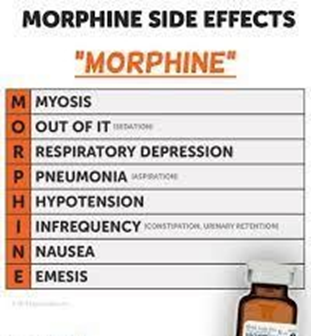A nurse is assessing a client who received morphine for severe pain 30 min ago. Which of the following findings is the nurse's priority?
Respiratory rate 7/min
Distended bladder
Last bowel movement was 3 days ago
Reports pain of 8 on a scale from 0 to 10
The Correct Answer is A
A. A respiratory rate of 7/min is below the normal range and may indicate opioid- induced respiratory depression, which is a life-threatening complication requiring immediate intervention.
B. While important, a distended bladder does not pose an immediate threat to the client's life compared to respiratory depression.
C. Constipation is a common side effect of opioid medications but does not require immediate intervention unless accompanied by severe symptoms such as fecal impaction or bowel obstruction.
D. Pain management is important, but respiratory depression takes priority as it can lead to respiratory arrest and death.

Nursing Test Bank
Naxlex Comprehensive Predictor Exams
Related Questions
Correct Answer is ["A","B","D"]
Explanation
A. The nurse's signature confirms that the client signed the informed consent document in the nurse's presence, verifying that the client provided consent voluntarily.
B. The nurse's signature confirms that the client has legal capacity and authority to provide consent for the proposed treatment or procedure.
C. The nurse's signature does not confirm the absence of a mental health condition; rather, it confirms that the client has provided informed consent.
D. The nurse's signature confirms that the client provided consent voluntarily and was not coerced or unduly influenced to do so.
E. While it is important for the client to understand the information provided, the nurse's signature does not specifically confirm this requirement.
Correct Answer is ["A","C","D"]
Explanation
A. This abbreviation can be misinterpreted as "units," "cc," or "you." It is recommended to avoid its use to prevent misinterpretation.
B. This abbreviation stands for intake and output, which is commonly used in healthcare documentation and is not on The Joint Commission's Do Not Use list.
C. IU can be mistaken for intravenous or international unit.
D. This abbreviation stands for once daily and is prone to misinterpretation, as it can be mistaken for qid (four times daily). It is recommended to avoid its use to prevent dosing errors.
E. This abbreviation stands for pro re nata, indicating "as needed" medication administration, and is not on The Joint Commission's Do Not Use list.
Whether you are a student looking to ace your exams or a practicing nurse seeking to enhance your expertise , our nursing education contents will empower you with the confidence and competence to make a difference in the lives of patients and become a respected leader in the healthcare field.
Visit Naxlex, invest in your future and unlock endless possibilities with our unparalleled nursing education contents today
Report Wrong Answer on the Current Question
Do you disagree with the answer? If yes, what is your expected answer? Explain.
Kindly be descriptive with the issue you are facing.
